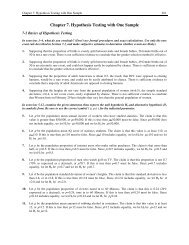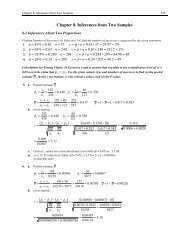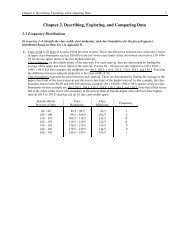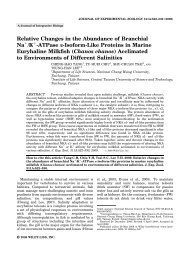Chapter 3. Probability
Chapter 3. Probability
Chapter 3. Probability
You also want an ePaper? Increase the reach of your titles
YUMPU automatically turns print PDFs into web optimized ePapers that Google loves.
78 <strong>Chapter</strong> 3: <strong>Probability</strong>16. Double frequencies in second row, compute new odds ratio182odds in favor of event for no helmet group0.3856Odds ratio ==2.13430 472 = =odds in favor of event for helmet group0.1807166The result for the odds ratio is the same as before the second row frequencies were doubled. While theindividual odds are reduced, the ratio of them remains the same.17. Yes, wearing a helmet appears to decrease the risk of facial injuries. The odds of having a facial injury whenwearing a helmet are 0.361 while the odds of having a facial injury when not wearing a helmet are 0.771, morethan twice as high.18. Risk ratio182P Proportion in no helmet group0.4354Relative Risk =1.64030 418nh== = =Ph Proportion in helmet group0.2655113Doubling frequencies in second row182P Proportionin no helmet group0.2783Relative Risk =1.81830 654nh== = =Ph Proportionin helmet group0.1531196Yes, the result changes since the base denominator for each group changes in proportion to the beginning totals.19. Tripling frequencies in first row of original table546odds in favor of event for no helmet group2.3136Odds ratio ==2.13490 236 = =odds in favor of event for helmet group1.084383546P Proportion in no helmet group0.6982Relative Risk =1.34290 782nh== = =Ph Proportion in helmet group0.5202173After tripling the first row frequencies or the event occurrence frequencies, there is no change in the odds ratio,but there is a change in the relative risk. The odds ratio is consistent which ever application there is(retrospective or prospective), but the relative risk changes depending on the application. Since the definition ofthe treatment and outcomes are applied to data already collected (retrospective) rather than for data directlyobserved in a controlled setting, the relative risk should be used only in prospective studies rather than in either.20. Design of Experimentsa. There would be several reasons for not doing this. Probably the most pertinent one would be that randomlyasking subjects to participate in a study where what they are asked to do could be detrimental, such as inthis case of asking one group to not wear seat belts when common wisdom is that such a practice preventsdeath or more serious injury, would be unethical. It would also be a violation of protection of humansubjects guidelines.b. It would be likely that some in the “no seat belt” group would use them anyway and some in the “seat belt”group would not use them, a problem often referred to as lack of compliance or lack of treatment fidelity.There would be no way to actually observe the use or lack of use in the two groups. This would confoundthe results of the study.
















